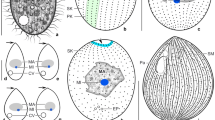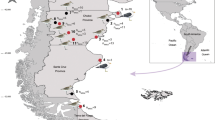Abstract
A new gregarine species, Thiriotia euchirellae n. sp. (Apicomplexa: Eugregarinorida), is described from the gut lumen of a mesopelagic copepod, Euchirella rostrata (Calanoida: Aetideidae), collected in Sagami Bay, Japan. Thiriotia euchirellae n. sp. has an elongated and cylindrical body with an average length of 174 μm, and is distinguished from its congeners by its shorter and thicker body, the rounded anterior end with thicker folds than for the rest of the body, and the posterior end covered by epicytic folds. Molecular phylogenetic analysis based on nuclear 18S rDNA placed T. euchirellae n. sp. in the clade of eugregarines infecting marine crustaceans, and in the same subclade as T. pugettiae. Thiriotia euchirellae n. sp. infected 95 % of the E. rostrata population, but was not detected in the other mesopelagic copepod species examined in the present study. Euchirella rostrata has an elongated gut with a swollen and sigmoidal anterior part and a gradually narrowing posterior part connected through a narrow path. Thiriotia euchirellae n. sp. were mostly observed in the posterior part of the gut. The high infection rate of E. rostrata by T. euchirellae n. sp. and the characteristic gut morphology of the host suggest a specific host–parasite relationship between these species.




Similar content being viewed by others
References
Apstein C (1911) Parasiten von Calanus finmarchicus. Wiss Meeresunters Kiel N F 13:205–222
Desportes I, Schrével J (2013) Treatise on zoology – anatomy, taxonomy, biology. The gregarines (2 vols): the early branching Apicomplexa (vol. 1). Brill, Boston
Fields DM, Runge JA, Thompson C, Shema SD, Bjelland RM, Durif CMF, Skiftesvik AB, Browman HI (2015) Infection of the planktonic copepod Calanus finmarchicus by the parasitic dinoflagellate, Blastodinium spp: effects on grazing, respiration, fecundity and fecal pellet production. J Plankton Res 37:211–220
Gobillard M-O (1964) Cephaloidophora petiti sp. n., grégarine parasite de copépodes pélagiques de la région de Banyuls. Vie et Milieu, suppl 17:107–113
Gouy M, Guindon S, Gascuel O (2010) SeaView version 4: a multiplatform graphical user interface for sequence alignment and phylogenetic tree building. Mol Biol Evol 27:221–224
Hecker KR, Forbes MR, Léonard NJ (2002) Parasitism of damselflies (Enallagma boreale) by gregarines: sex biases and relations to adult survivorship. Can J Zool 80:162–168
Ho J, Perkins PS (1985) Symbionts of marine copepoda: an overview. Bull Mar Sci 37:586–598
Katoh K, Standley DM (2013) MAFFT multiple sequence alignment software version 7: improvements in performance and usability. Mol Biol Evol 30:772–780
Leander BS, Clopton RE, Keeling PJ (2003) Phylogeny of gregarines (Apicomplexa) as inferred from small-subunit rDNA and β-tubulin. Int J Syst Evol Microbiol 53:345–354
Longhurst AR (1985) Relationship between diversity and the vertical structure of the upper ocean. Deep-Sea Res A 32:1535–1570
Mauchline J (1998) The biology of calanoid copepods. Advances in marine biology, 33. Academic, New York
Motoda S (1971) Devices of simple plankton apparatus V. Bull Fac Fish Hokkaido Univ 22(2):101–106
Nylander JAA (2004) MrModeltest v2. Program distributed by the author. Evolutionary Biology Centre, Uppsala University
Ohtsuka S, Onbé T (1989) Evidence of selective feeding on larvaceans by the pelagic copepod Candacia bipinnata (Calanoida: Candaciidae). J Plankton Res 11:869–872
Ohtsuka S, Böttger-Schnack R, Okada M, Onbé T (1996) In situ feeding habits of Oncaea (Copepoda: Poecilostomatoida) from the upper 250 m of the central Red Sea, with special reference to consumption of appendicularian houses. Bull Plankton Soc Jpn 43:89–105
Omori M (1965) A 160 cm opening-closing plankton net. I. Description of the gear. J Oceanogr Soc Jpn 21:212–220
Prokopowicz AJ, Rueckert S, Leander BS, Michaud J, Fortier L (2010) Parasitic infection of the hyperiid amphipod Themisto libellula in the Canadian Beaufort Sea (Arctic Ocean), with a description of Ganymedes themistos sp. n. (Apicomplexa, Eugregarinorida). Polar Biol 33:1339–1350
Rodriguez Y, Omoto CK, Gomulkiewicz R (2007) Individual and population effects of eugregarine, Gregarina niphandrodes (Eugregarinida: Gregarinidae), on Tenebrio molitor (Coleoptera: Tenebrionidae). Environ Entomol 36:689–693
Ronquist F, Huelsenbeck JP (2003) MrBayes 3: Bayesian phylogenetic inference under mixed models. Bioinformatics 19:1572–1574
Rueckert S, Simdyanov TG, Aleoshin VV, Leander BS (2011) Identification of a divergent environmental DNA sequence clade using the phylogeny of gregarine parasites (Apicomplexa) from crustacean hosts. PLoS ONE 6:e18163
Sano M, Maki K, Nishibe Y, Nagata T, Nishida S (2013) Feeding habits of mesopelagic copepods in Sagami Bay: insights from integrative analysis. Prog Oceanogr 110:11–26
Schilder RJ, Marden JH (2006) Metabolic syndrome and obesity in an insect. Proc Natl Acad Sci U S A 103:18805–18809
Takahashi KT, Kawaguchi S, Toda T (2009) Observation by electron microscopy of a gregarine parasite of Antarctic krill: its histological aspects and ecological explanations. Polar Biol 32:637–644
Takishita K, Yubuki N, Kakizoe N, Inagaki Y, Maruyama T (2007) Diversity of microbial eukaryotes in sediment at a deep-sea methane cold seep: surveys of ribosomal DNA libraries from raw sediment samples and two enrichment cultures. Extremophiles 11:563–576
Tamura K, Stecher G, Peterson D, Filipski A, Kumar S (2013) MEGA6: molecular evolutionary genetics analysis version 6.0. Mol Biol Evol 30:2725–2729
Théodoridès J (1989) Parasitology of marine zooplankton. In: Blaxter JHS, Southward AJ (eds) Advances in marine biology, 25. Academic, New York, pp 117–177
Thomas F, Oget E, Gente P, Desmots D, Renaud F (1999) Assortative pairing with respect to parasite load in the beetle Timarcha maritima (Chrysomelidae). J Evol Biol 12:385–390
Acknowledgments
We sincerely thank the captain and crewmembers of the R/V ‘Tansei-Maru’ and the staff members of the Plankton Laboratory and the Center for International Collaboration of the Atmosphere and Ocean Research Institute. We also thank Masako Hara for her support with SEM analyses. This study has been partially supported by grants from the Japan Society for the Promotion of Science (Multilateral Cooperative Research Program, Coastal Oceanography) and the Alfred P. Sloan Foundation (Census of Marine Zooplankton) awarded to S.N.
Author information
Authors and Affiliations
Corresponding author
Additional information
Communicated by B. Leander
Rights and permissions
About this article
Cite this article
Sano, M., Miyamoto, H. & Nishida, S. Thiriotia euchirellae n. sp., a new gregarine species (Apicomplexa: Eugregarinorida) from the mesopelagic copepod Euchirella rostrata in Sagami Bay, Japan. Mar Biodiv 46, 753–760 (2016). https://doi.org/10.1007/s12526-015-0423-8
Received:
Revised:
Accepted:
Published:
Issue Date:
DOI: https://doi.org/10.1007/s12526-015-0423-8




